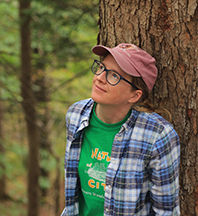Week of January 8, 2023 – January 14, 2023
by Anna Stunkel, Environmental Educator
As a new year begins, I enjoy pausing to reflect on special experiences in nature from the past year. One of these moments happened just as the year was ending, when my dad and I were birding in one of our favorite spots: Parker River National Wildlife Refuge, on the north shore of Massachusetts.
As we were driving along the refuge’s main road, we noticed many cars stopped and people with cameras and binoculars, an encouraging sign! Sure enough, the beautiful Barred Owl pictured here was sitting right beside the road. We watched the owl from a respectful distance as he or she pounced several times in pursuit of prey. As the sun went down, the owl’s silhouette was a peaceful sight. Just as we were about to leave, the owl lifted off and flew right past us! We could even feel the whoosh of air as this powerful bird disappeared into the bushes.
Barred Owls are well-loved birds with soulful, deep brown eyes, mysterious, echoing hoots, and an affinity for living in swamps. While they are rare at Baltimore Woods, these owls are more easily found in other nearby areas with mature forest and wetlands such as Green Lakes State Park, Labrador Hollow, and Whiskey Hollow.
Barred Owls are known for their cackling, barking calls that often sound like, “who-cooks-for-YOU!” While generally most active at night, they also call during the day, especially during cloudy weather. Barred Owls nest in tree cavities and are very adaptable birds with varied diets. Small mammals, birds, reptiles, amphibians, and even invertebrates such as crayfish are all possibilities on their menu.
If you spot an owl in the wild, enjoy this special moment respectfully by giving the bird space. This time of year is an excellent season to listen for Barred Owls, who prepare to nest quite early in mid- to late winter.


